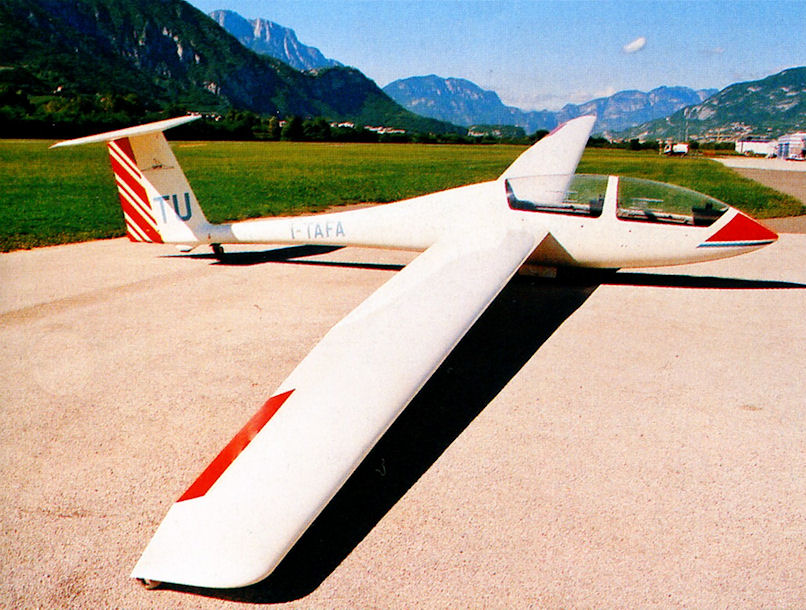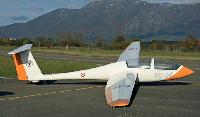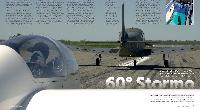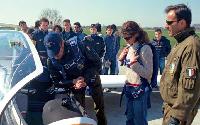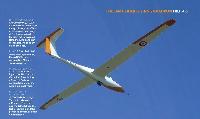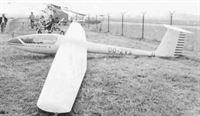Grob G 109
Компания "Burkhart Grob Flugzeugbau" из германского Туссенхаузена вышла на авиационный рынок в 1971 году. Поначалу она занималась разработкой планеров, обладавших высокими характеристиками. Первым из них стал Standard Cirrus, выпускавшийся в 1972-1975 годах по лицензии фирмы "Schempp-Hirth". В 1988 году компания изменила свое наименование на "Burkhart Grob Luft- und Raumfahrt G.m.b.H.". Отделение легкой авиации этой компании продолжило разработку планеров, включая известный G 103 Twin II Aero, поставлявшийся в Британию под наименованием Viking T.Mk 1. Отделение тяжелой авиации сконцентрировалось на разработке, производстве и маркетинге самолетов и мотопланеров.
<...>
Показать полностьюShow all
M.Hardy. Gliders & Sailplanes of the world
Grob G-102 Astir CS
This high performance Standard Class single-seater is designed and produced by the German firm of Burkhart Grab Flugzeugbau GmbH, who also built the Schempp-Hirth Standard Cirrus under licence during 1972-75. The Astir CS (Club Standard) is intended for clubs and private owners looking for a modern all-glassfibre design that is easy to fly and has a roomy cockpit. Construction of the prototype Astir CS began in March 1974, and it first flew on 19 December that year; it went into production in July 1975 and soon proved to be popular, a total of 534 having been delivered before being succeeded by the Astir CS 77. The Astir was offered in two versions, the Standard Astir and Club Astir, the latter having a non-retractable monowheel and no provision for water ballast. The current standard version, the Astir CS 77, has a new slimmer and larger fuselage and modified tailplane actuation and made its first flight on 26 March 1977; nearly 400 of the CS 77 and Club Astir had been built by the end of 1978. The cantilever mid wings have glassfibre roving main spars and a glassfibre/epoxy resin sandwich skin except for the ailerons, which are of glassfibre sandwich. There are Schempp-Hirth aluminium air brakes in the wing upper surfaces, but no flaps, and up to 220lb of water ballast can be carried in tanks in the wings, being jettisoned via a dump valve in the fuselage. Rigging is carried out without any separate removable parts as the wings and the tailplane are attached by a system of 'snaplock' connectors. The glassfibre semi-monocoque fuselage has a towing/launching hook, and the large one-piece cockpit canopy opens sideways to starboard. Construction of the T-tail unit is the same as that of the wings. The Astir CS 77 has a retractable monowheel with an internally-expanding drum brake, which folds up behind closed doors, and there is also a rubber-sprung tail wheel. The Astir CSM was a powered version under development in mid-1976 with a 25hp Fichtel & Sachs Wankel KM24 rotating piston engine on a retractable pylon aft of the pilot, driving a two-blade Hoffman tractor propeller. A 6.6 gal fuel tank is fitted.
The Club Astir II and the Standard Astir II featured the new fuselage of the Speed Astir II, with a one-piece canopy, as well as the elasticated flaps of the Speed version and a new wing tip profile. Current production variants are the Club Astir III, IIIB and Standard Astir III, which have a roomier cockpit and reduced empty weight. The IIIB has its monowheel further aft and a small wheel added under the cockpit to improve ground handling.
Data: Astir CS 77
Span: 49 ft 2 1/2 in
Length: 21 ft 11 1/4 in
Height: 4 ft 7 in
Wing area: 133.5 sqft
Aspect ratio: 18.2
Empty weight: 595 lb
Max weight: 992 lb
Max speed: 155 mph
Max aero-tow speed: 105 mph
Min sinking speed: 1.97 ft/sec at 47 mph
Best glide ratio: 38:1 at 65 mph
Grob G-103 Twin Astir
This is the tandem two-seater version of the Astir CS, differing from it principally in having a fuselage lengthened by 9 3/4 in to accommodate the second seat, and also reduced in depth by 1 1/2 in; wing span has been increased to 17.5m (57ft 5in) and the wings are now swept forward 3° 18'. Dual controls are provided under the two individual canopies, and the Twin Astir is offered to customers both with and without the basic instruments in the front cockpit and with or without water ballast, of which up to 198lb can be carried. Design of the Twin Astir began in September 1974 and construction of the prototype was commenced in March 1976; this made its first flight on 31 December 1976. By the end of 1978 over 225 Twin Astirs had been delivered; production has now ended. The type is also known as the Twin Astir Trainer when used for this task. The Twin Astir has the same mid wing position and T-tail as its single-seat counterpart, and is of the same glassfibre construction. Unlike many two-seaters which have fixed landing gear, the Twin Astir at first had a retractable monowheel but because the rear seat, positioned on the centre of gravity, takes up the space that would normally be used for retraction the wheel is rotated sideways through 90° to fit in horizontally under the rear seat; the monowheel is now fixed.
Span: 57 ft 5 in
Length: 26 ft 8 3/4 in
Height: 5 ft 3 in
Wing area: 192.7 sqft
Aspect ratio: 17.1
Empty weight: 860 lb
Max weight: 1,367 lb
Max speed: 155 mph (smooth air)
Max aero-tow speed: 105 mph
Min sinking speed: 2.40 ft/sec at 56 mph
Best glide ratio: 38:1 at 68.5 mph
Grob G-103 Twin II
Formerly the G118, the Twin II is a new tandem two-seater for training and club use to succeed the Twin Astir, from which it differs in having a narrower and more streamlined fuselage, improved cockpit layout and larger canopies, lower-set wings, a fixed monowheel plus a small wheel (likewise semi-recessed) under the forward cockpit and a tailwheel, downturned wing tips and reduced empty weight. The same type of elasticated flaps as featured on the Speed Astir are fitted, and the T-tail is similar to the Twin Astir's. Unlike the latter, no water ballast is carried. The Twin II first flew late in 1979.
Span: 57 ft 5 in
Length; 26 ft 10 in
Height: 8 ft 1 in
Wing area: 191.6 sqft
Aspect ratio: 17.2
Empty weight :794 lb
Max take-off weight: 1,278 lb
Max speed: 155 mph (smooth air)
Max aero-tow speed: 105 mph
Min sinking speed: 2.10 ft/sec at 50 mph
Best glide ratio: 37:1 at 65 mph
Grob G-104 Speed Astir II
This single-seater Unrestricted 15m Class version of the Astir is generally similar to the Astir CS 77 except for wings of reduced area and different section, which have carbon-fibre spars and are fitted with so called 'elastic flaps' in which the gaps between the flap and the wing trailing edge are elastically sealed; these flaps can be deflected upwards to act as air brakes as well as downwards, and the ailerons can be drooped with the flaps. The Speed Astir has the same cantilever mid-wing and T-tail as the Astir, but with a shorter fin and rudder and constructionally it is the same as its predecessor. The water ballast capacity has been increased to 330lb. After 25 of the original Speed Astirs had been built, production switched to the Speed Astir II which first flew on 11 November 1978. This had a new and slimmer laminar flow fuselage, with carbon-fibre reinforcements in high stress areas, and a two-piece canopy, the rear section of which hinges to open aft. In October 1979 the cockpit was lengthened by nearly 8in to accommodate taller pilots, and the Speed Astir IIB has carbon-fibre spars. From the same date the Speed Astir II 17.5, a version with a longer span of 17.5m, was due to become available. Altogether 98 Speed Astir IIs had been built by December 1979 and the type is currently out of production.
Data: Speed Astir II
Span: 49 ft 2 1/2 in
Length: 21 ft 11 1/4 in
Height: 4 ft 2 in
Wing area: 123.5 sqft
Aspect ratio: 19.6
Empty weight: 584 lb
Max weight: 1,135 lb
Max speed:168 mph (smooth air)
Min sinking speed: 1.97 ft/sec at 47 mph
Best glide ratio: 41.5:1 at 74.5 mph
Показать полностьюShow all
